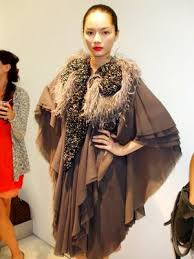Source(google.com.pk)
Japanese Fashion Models Biography
Yuka Kyomoto is a Japanese supermodel. She was born in the city of Niigata in her home country of Japan. She stands at 154 centimeters tall. She has the blood type of A. Yuka entered this world on April 6, 1986. She is under contract with the talent agency Shining Will. In Japan, supermodels go by another name as well. They are called gravure or bikini models but they are not very popular in the United States. But in Japan, they make big news especially when they release new DVDs. Then they generally meet and greet their fans at promotional events.
With all the negative news about Japan since the earthquake and tsunami that happened over there here is something good to read. This will get all fans of the entertainment industry really excited. I guarantee it!!
Yuka started her modeling career in the year 2004. She makes regular appearances as a guest on Japanese television shows. It is also said that she is a fan of the Japanese baseball team called Yokohama Bay Stars. She is popular in Japan because of the fact that she is able to entertain her fans by posing in a certain way. She is also one of the cutest Japanese models in the entire country. She’s got those sparkling brown eyes that are really pretty. I consider her to be similar in looks to supermodel Sayaka Isoyama but her breasts aren’t as big. Her sexiness can be attributed to the fact that she does photo shoots usually in bikinis.
The headline image this week may well prove to be the one shown above, from an exhibition of Richard Avedon’s work that has just opened in Milan, sponsored by Versace. In days of yore, Avedon’s collaboration with the supermodels for Versace’s ads became as much a part of the wallpaper of the 1990s as Oasis and Blur were the soundtrack. But there are no supermodels now, only (mainly) anonymous Eastern Europeans who, besides being built differently from the supers (who were thin but not emaciated), exude a kind of dislocated isolation as opposed to the supers’ imperious sexiness. The Eastern Europeans are less prone to diva behaviour and more likely to accept lower pay and inferior working conditions. As for using men as footstools and sofas, what would be the point? They wouldn’t be able to weigh them down, nor be convincing as women in charge.
Two weeks into the shows and you’d assume, reasonably, that we’d have identified the season’s It trends among the audience. For the industry these are the key trends (it’s easy to reel off a list of catwalk developments for next winter, but often these are a bit theoretical).
The audience’s peccadillos, on the other hand, provide a snapshot of what’s being adopted here and now, and since almost no one ever wears anything to a show without serious consideration, these are the trends that professional cool-finders monitor and decode (ie, pass on to clients, having exchanged vast cool-finder fees first, obviously). Hence the hordes of Japanese photographers. They don’t even try to get accreditation – they’re busy capturing details, from Alexa Chung’s laddered tights (look out for the couture version next winter) to Anna Wintour’s notebook.
But something weird is going on. No one bag is monopolising the arms of the fashion pack. There isn’t even a uniform size, though refuse sacks appear to be on the wane. Shoes, then? Sorry – not much enlightenment here either. Admittedly, the platform sole still dominates. But it could be attached to a boot, a shoe-boot, a robotic Balenciaga-esque sandal . . . Other big trends not spotted on the audience: full skirts, dresses, chiffon or jumpsuits. In fact, the only universal evolution is the higher waist, but even this comes with a multiple choice – skinny jean or flared.
Maybe it’s just too cold even for fashion editors to wear chiffon – but cold never used to be a consideration when showing off a spring wardrobe. So maybe something is going on. Certainly, the main imperative has been to dress warm. When Keira Knightley shoved a cosy jacket over her Valentino at the Baftas, she was actually being prescient. And back in Milan, parkas are cropping up on those who once frolicked in cocktail dresses. Michael Kors called this Limo Dressing, denoting wealth and a waiting chauffeur. But Limo Dressing is being replaced by Statement Layering: piling on thin jumpers. As for bare legs, they’ve been replaced by 80-denier woollen tights or, for the 1980s groupie, sheer black stockings, seen among others, at Missoni, left. In the face of global warming, maybe the ultimate luxury is dressing for the cold.










Japanese Fashion Models Biography
Yuka Kyomoto is a Japanese supermodel. She was born in the city of Niigata in her home country of Japan. She stands at 154 centimeters tall. She has the blood type of A. Yuka entered this world on April 6, 1986. She is under contract with the talent agency Shining Will. In Japan, supermodels go by another name as well. They are called gravure or bikini models but they are not very popular in the United States. But in Japan, they make big news especially when they release new DVDs. Then they generally meet and greet their fans at promotional events.
With all the negative news about Japan since the earthquake and tsunami that happened over there here is something good to read. This will get all fans of the entertainment industry really excited. I guarantee it!!
Yuka started her modeling career in the year 2004. She makes regular appearances as a guest on Japanese television shows. It is also said that she is a fan of the Japanese baseball team called Yokohama Bay Stars. She is popular in Japan because of the fact that she is able to entertain her fans by posing in a certain way. She is also one of the cutest Japanese models in the entire country. She’s got those sparkling brown eyes that are really pretty. I consider her to be similar in looks to supermodel Sayaka Isoyama but her breasts aren’t as big. Her sexiness can be attributed to the fact that she does photo shoots usually in bikinis.
The headline image this week may well prove to be the one shown above, from an exhibition of Richard Avedon’s work that has just opened in Milan, sponsored by Versace. In days of yore, Avedon’s collaboration with the supermodels for Versace’s ads became as much a part of the wallpaper of the 1990s as Oasis and Blur were the soundtrack. But there are no supermodels now, only (mainly) anonymous Eastern Europeans who, besides being built differently from the supers (who were thin but not emaciated), exude a kind of dislocated isolation as opposed to the supers’ imperious sexiness. The Eastern Europeans are less prone to diva behaviour and more likely to accept lower pay and inferior working conditions. As for using men as footstools and sofas, what would be the point? They wouldn’t be able to weigh them down, nor be convincing as women in charge.
Two weeks into the shows and you’d assume, reasonably, that we’d have identified the season’s It trends among the audience. For the industry these are the key trends (it’s easy to reel off a list of catwalk developments for next winter, but often these are a bit theoretical).
The audience’s peccadillos, on the other hand, provide a snapshot of what’s being adopted here and now, and since almost no one ever wears anything to a show without serious consideration, these are the trends that professional cool-finders monitor and decode (ie, pass on to clients, having exchanged vast cool-finder fees first, obviously). Hence the hordes of Japanese photographers. They don’t even try to get accreditation – they’re busy capturing details, from Alexa Chung’s laddered tights (look out for the couture version next winter) to Anna Wintour’s notebook.
But something weird is going on. No one bag is monopolising the arms of the fashion pack. There isn’t even a uniform size, though refuse sacks appear to be on the wane. Shoes, then? Sorry – not much enlightenment here either. Admittedly, the platform sole still dominates. But it could be attached to a boot, a shoe-boot, a robotic Balenciaga-esque sandal . . . Other big trends not spotted on the audience: full skirts, dresses, chiffon or jumpsuits. In fact, the only universal evolution is the higher waist, but even this comes with a multiple choice – skinny jean or flared.
Maybe it’s just too cold even for fashion editors to wear chiffon – but cold never used to be a consideration when showing off a spring wardrobe. So maybe something is going on. Certainly, the main imperative has been to dress warm. When Keira Knightley shoved a cosy jacket over her Valentino at the Baftas, she was actually being prescient. And back in Milan, parkas are cropping up on those who once frolicked in cocktail dresses. Michael Kors called this Limo Dressing, denoting wealth and a waiting chauffeur. But Limo Dressing is being replaced by Statement Layering: piling on thin jumpers. As for bare legs, they’ve been replaced by 80-denier woollen tights or, for the 1980s groupie, sheer black stockings, seen among others, at Missoni, left. In the face of global warming, maybe the ultimate luxury is dressing for the cold.
Japanese Fashion Models
Japanese Fashion Models
Japanese Fashion Models
Japanese Fashion Models
Japanese Fashion Models
Japanese Fashion Models
Japanese Fashion Models
Japanese Fashion Models
Japanese Fashion Models
Japanese Fashion Models
Japanese Fashion Models
No comments:
Post a Comment